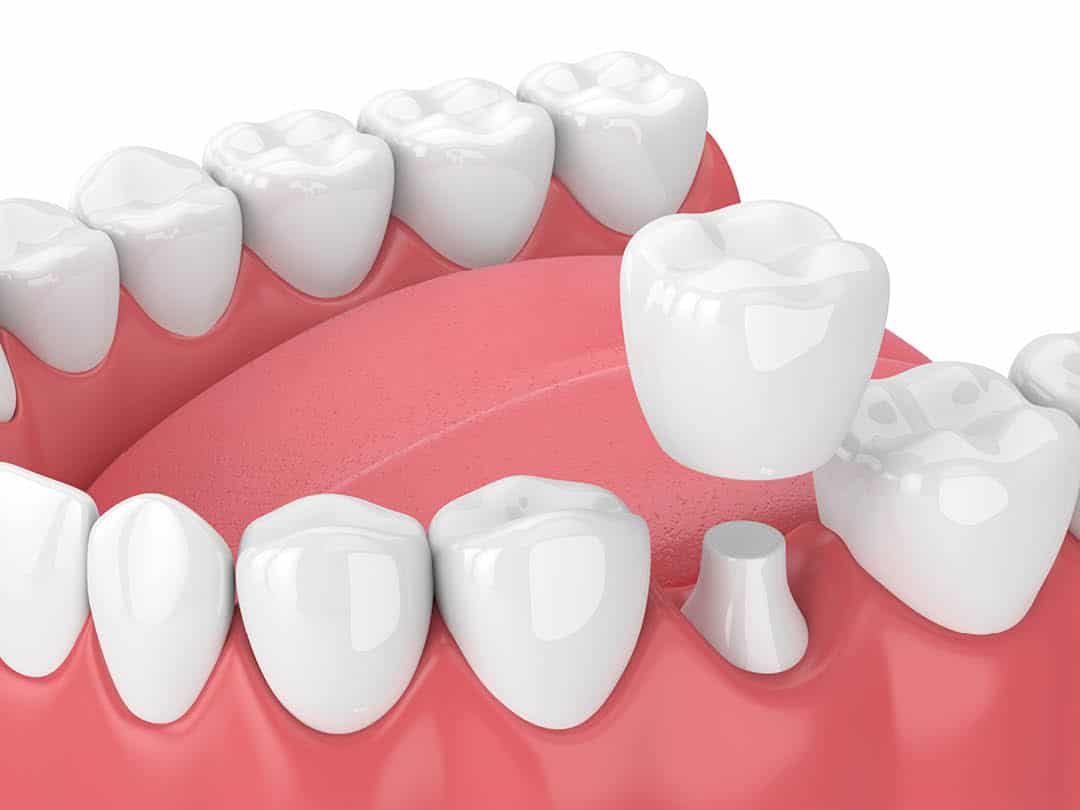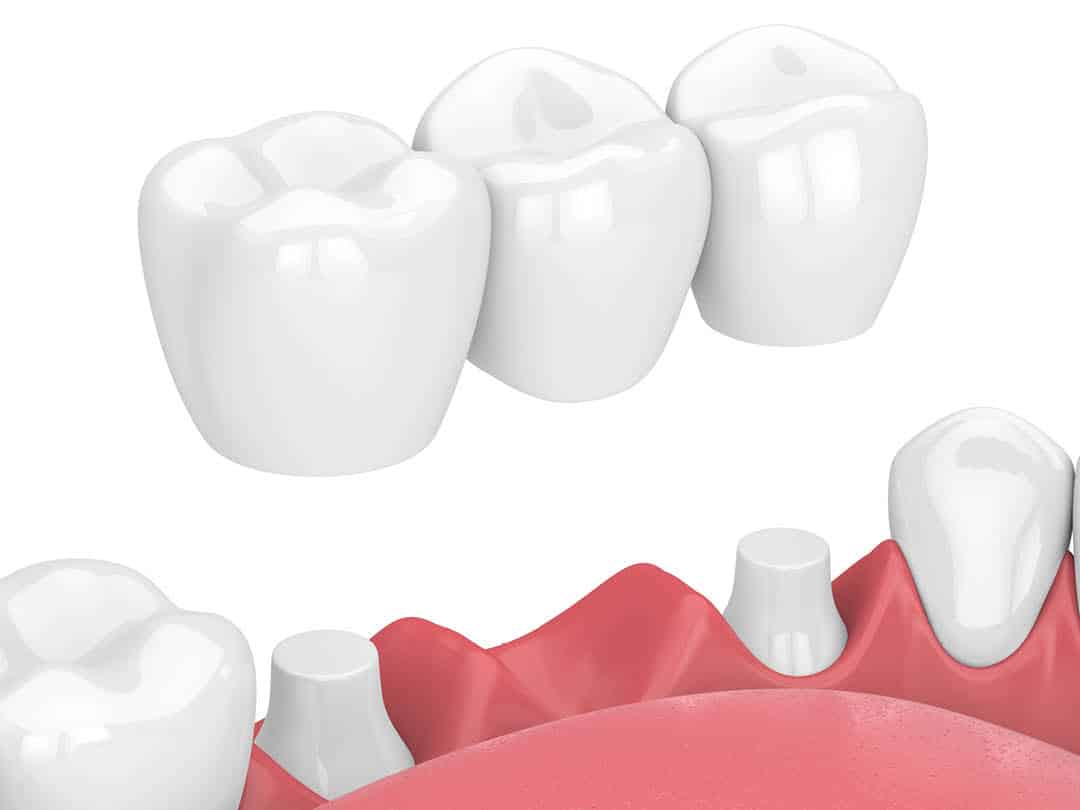Dental crowns and bridges are two of the most common restorative procedures in modern dentistry. These treatments help restore the function and appearance of damaged or missing teeth, providing patients with renewed confidence in their smiles. In this comprehensive guide, we’ll explore what dental crowns and bridges are, their benefits, the materials used, and the procedures involved.

Understanding Dental Crowns
A dental crown, often called a “cap,” is a custom-made covering that fits over an entire tooth. Crowns restore the shape, size, strength, and appearance of a damaged tooth. They’re typically recommended when a tooth is too damaged for a simple filling but don’t require extraction.
Dental Crown Benefits:
- Protection of weak or damaged teeth
- Restoration of broken or severely worn teeth
- Coverage for dental implants
- Improvement of the appearance of misshapen or discoloured teeth
- Support for teeth with large fillings
Crown Preparation:
The process of getting a crown usually involves two visits to the dentist. During the first visit, the dentist will:
- Examine and prepare the tooth
- Take impressions for the permanent crown
- Place a temporary crown
In the second visit, the dentist will remove the temporary crown and cement the permanent crown in place.
Dental Crown Materials:
Several materials are used for creating dental crowns, each with its own advantages:
- Porcelain: Offers the most natural appearance and is ideal for front teeth.
- Porcelain-fused-to-metal: Combines strength with aesthetics.
- Gold alloys: Extremely durable and gentle on opposing teeth.
- Base metal alloys: Strong and corrosion-resistant.
- Zirconia: A newer material offering strength and a natural appearance.
Dental Crown Colour Matching:
One of the key aspects of creating a natural-looking crown is colour matching. Dentists use shade guides to select the crown colour that best matches the surrounding teeth. Advanced dental practices may use digital shade-matching technology for even more precise results.

Understanding Dental Bridges
A dental bridge is a fixed prosthetic device used to replace one or more missing teeth. It consists of one or more artificial teeth (pontics) held in place by dental crowns on either side.
Types of Dental Bridges:
- Traditional bridges: Most common type, involving crowns on adjacent teeth.
- Cantilever bridges: Used when there are teeth on only one side of the gap.
- Maryland bridges: Use a metal or porcelain framework bonded to the back of adjacent teeth.
- Implant-supported bridges: Anchored by dental implants instead of natural teeth.
Permanent Bridge:
A permanent bridge is designed to be a long-lasting solution for missing teeth. It’s cemented in place and can only be removed by a dentist.
Bridge Adjustment:
After the initial placement, patients may need bridge adjustments to ensure proper fit and comfort. This process involves minor modifications to the bridge to improve its alignment with the bite and surrounding teeth.
The Procedure for Crowns and Bridges
Crown Preparation:
- Tooth examination and preparation
- Taking impressions
- Placement of a temporary crown
- Fabrication of permanent crown (usually takes 1-2 weeks)
- Fitting and cementing of a permanent crown
Bridge Procedure:
- Preparation of abutment teeth
- Taking impressions
- Placement of a temporary bridge
- Fabrication of permanent bridge
- Fitting and cementing of a permanent bridge
Replacing Old Crowns:
Crowns may need replacement due to wear, damage, or aesthetic reasons. The process is similar to getting a new crown, involving removal of the old crown, preparation of the tooth, and placement of a new crown.
Temporary Crown:
A temporary crown is placed to protect the prepared tooth while the permanent crown is being made. It’s typically made of acrylic and is not meant for long-term use.
Common FAQs
- Is getting a crown and bridge painful?
- The procedure is usually not painful as it’s performed under local anaesthesia. Some patients may experience mild discomfort or sensitivity after the procedure, which typically subsides within a few days.
- What are the disadvantages of a crown and bridge?
- Requires removal of healthy tooth structure
- Might need replacing after 10-15 years
- Potential for sensitivity to hot and cold
- Risk of decay if oral hygiene is poor
- How long does the process of getting a crown and bridge take?
- The process usually takes 2-3 weeks, involving two dental visits. The first visit is for preparation and impressions, and the second is for placement of the permanent crown or bridge.
Expert Opinion and Statistics
Dr Sarah Johnson, a leading cosmetic dentist in London, states, “Dental crowns and bridges have revolutionised restorative dentistry. They offer patients a chance to regain function and aesthetics, often with life-changing results.”
According to a 2022 survey by the British Dental Association, 68% of UK adults have had some form of restorative dental work, with crowns and bridges being among the most common procedures.
Caring for Your Crown and Bridge
To ensure the longevity of your dental crown or bridge:
- Maintain excellent oral hygiene
- Avoid biting on hard objects or foods
- Use a night guard if you grind your teeth
- Attend regular dental check-ups
- Be cautious with sticky foods that could dislodge the crown or bridge
Conclusion
Dental crowns and bridges are invaluable in modern dentistry, offering solutions for damaged or missing teeth. By understanding the procedures, materials, and care involved, patients can make informed decisions about their dental health. Whether you’re considering a crown for a damaged tooth or a bridge to replace missing teeth, these restorative options can significantly improve both the function and appearance of your smile.
Remember, the key to successful dental restorations lies not only in the skill of your dentist but also in your commitment to maintaining good oral health. With proper care, your dental crown or bridge can provide you with years of comfortable, confident smiling.


